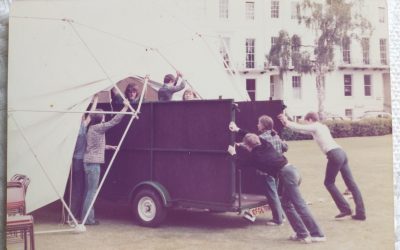Zoom music-making has been a feature of lockdown. Hardly a week passes without someone sending me a link to a recording: Zoom choirs, Zoom orchestras and ensembles, each performer singing or playing away in their own home and on their own little screen.
To create a composite whole, each person usually has to record their individual part and upload it to be combined with others. Until that’s done, nobody can hear the total effect.
Don’t get me wrong: I think Zoom music-making has brought a sense of community and positivity to many people during the lonely weeks of lockdown. It’s remarkable that such a thing can happen at all, and it’s a great use of modern technology.
However, it makes me sad to think that people may think that that’s what collaborative music-making is always like – parallel parts played simultaneously, without knowledge of one another. Because for me the great pleasure and interest of chamber music is the way we influence one another in real time as we play.
You start off by preparing your own individual part, of course. But the collaborative magic begins when you’re in the same space as the other musicians and you hear how they’re playing their parts. As their ideas emerge through the music, you might think, ‘Ah, I like that. I could join in with that colour, that mood.’ You alter the way you’re playing because of what you hear. If you have a strong feeling about how something should go, and you play it in a convincing way, you’ll hear others altering their way of playing to join in with you, to amplify your vision.
As you hear all the parts in their proper context, you develop a sense of perspective not available when you’re practising alone at home. You may suddenly realise that your individual line is not the most important one, and you drop down in the layers of music – or you may realise that it is the most important, and you can surge to the forefront. The tone and tempo that your fellow players choose, the varieties of loud and soft they want to try, the emotions they want to bring out – chamber musicians send out these musical messages with faith that other players will respond constructively. In this way, the individual parts become more than separate lines – they become dynamic and inter-dependent.
It’s a bit like a conversation – a good conversation, anyway – where someone speaks and the next person’s contribution is influenced by what’s just been said, and the way it was said.
In a conversation, however, one person speaks at a time. The beauty of collaborative music is that several people can ‘speak’ at the same time, but still be responsive to the others. You’re not just saying what you want to say – you’re factoring in what others want to say as well. How you go round musical corners together, how you approach high and low points, how you can contribute to the energy of the performance – these are discoveries you make together in rehearsal, and sometimes even more so in performance.
When your antennae are finely tuned to one another, this kind of real-time adjustment and blending of ideas feels like not just a conversation, but a microcosm of the way social interaction should work.




I wonder to what extent as a musician you feel audiences may also ‘contribute’ to a chamber music performance? Whilst audience members cannot directly be a part of the ‘conversation’ you describe, it often seems to me that, when an ensemble plays really well in an intimate auditorium, a very attentive audience also provides its own kind of ‘energy’ to the occasion. If this is not entirely illusory, it must of course be missing from almost every recording experience – not just Zoom compilations!
Very good point, Paul, which I should have made. Absolutely – the audience can contribute so much to the feeling of the performance. Speaking for myself, if I sense that the audience is really listening, it inspires me to try for as many nuances as possible.
It’s always puzzling that a random collection of individuals can have ‘a character’, but certainly the audience does seem to have a character which varies from night to night, or place to place.
We tried to do something similar but it turned out to be a bit challenging…